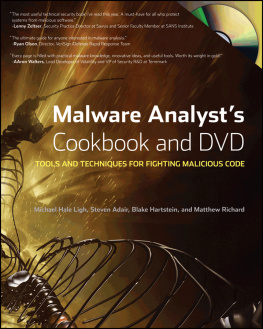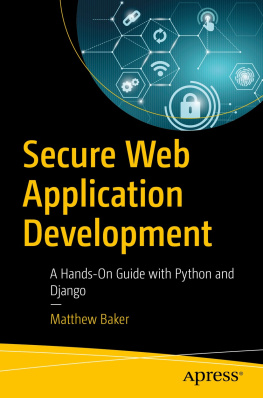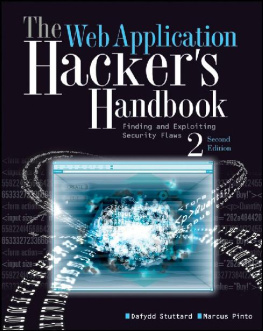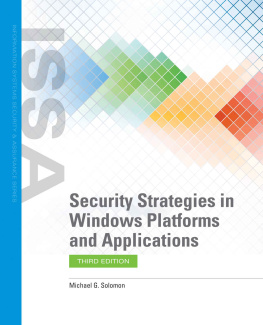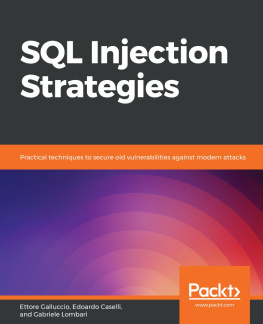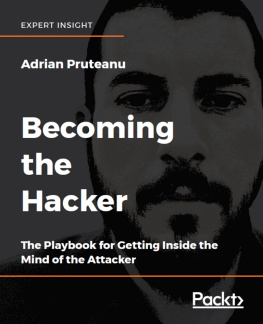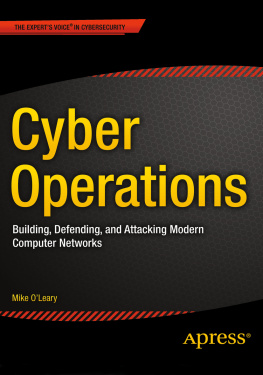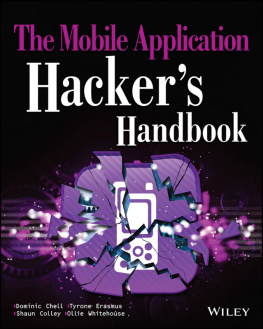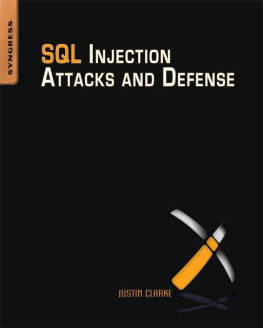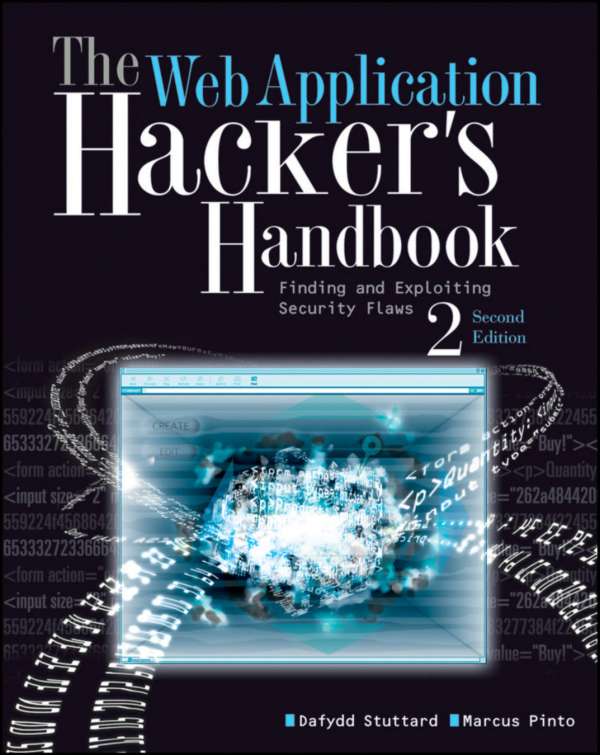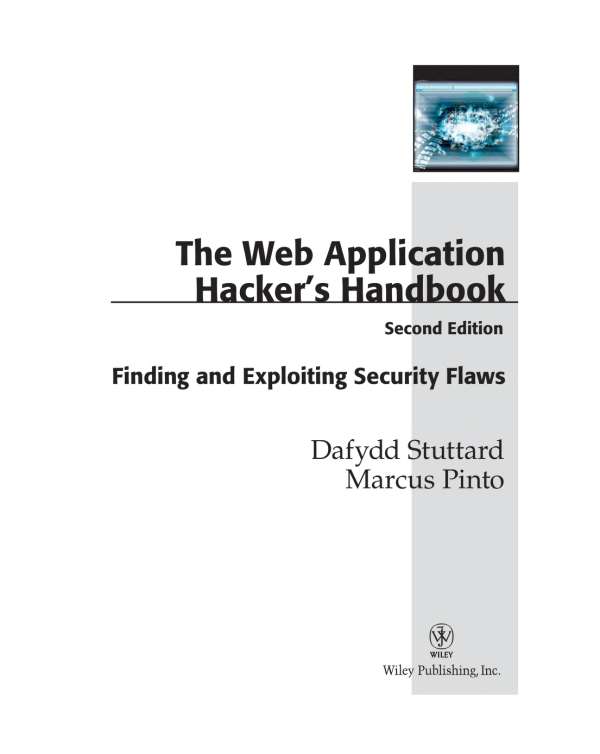The Web Application Hacker's Handbook: Finding and Exploiting Security Flaws, Second Edition
Published by
John Wiley & Sons, Inc.
10475 Crosspoint Boulevard Indianapolis, IN 46256 www.wiley.com
Copyright 2011 by Dafydd Stuttard and Marcus Pinto Published by John Wiley & Sons, Inc., Indianapolis, Indiana
Published simultaneously in Canada
ISBN: 978-1-118-02647-2 ISBN: 978-1-118-17522-4 (ebk)
ISBN: 978-1-118-17524-8 (ebk)
ISBN: 978-1-118-17523-1 (ebk)
Manufactured in the United States of America
10 987654321
No part of this publication may be reproduced, stored in a retrieval system or transmitted in any form or by any means, electronic, mechanical, photocopying, recording, scanning or otherwise, except as permitted under Sections 107 or 108 of the 1976 United States Copyright Act, without either the prior written permission of the Publisher, or authorization through payment of the appropriate per-copy fee to the Copyright Clearance Center, 222 Rosewood Drive, Danvers, MA 01923, (978) 750-8400, fax (978) 646-8600. Requests to the Publisher for permission should be addressed to the Permissions Department, John Wiley & Sons, Inc., Ill River Street, Hoboken, NJ 07030, (201) 748-6011, fax (201) 748-6008, or online at http : / /www. wiley. com/go/permissions.
Limit of Liability/Disclaimer of Warranty: The publisher and the author make no representations or warranties with respect to the accuracy or completeness of the contents of this work and specifically disclaim all warranties, including without limitation warranties of fitness for a particular purpose. No warranty may be created or extended by sales or promotional materials. The advice and strategies contained herein may not be suitable for every situation. This work is sold with the understanding that the publisher is not engaged in rendering legal, accounting, or other professional services. If professional assistance is required, the services of a competent professional person should be sought. Neither the publisher nor the author shall be liable for damages arising herefrom. The fact that an organization or Web site is referred to in this work as a citation and/or a potential source of further information does not mean that the author or the publisher endorses the information the organization or website may provide or recommendations it may make. Further, readers should be aware that Internet websites listed in this work may have changed or disappeared between when this work was written and when it is read.
For general information on our other products and services please contact our Customer Care Department within the United States at (877) 762-2974, outside the United States at (317) 572-3993 or fax (317) 572-4002.
Wiley also publishes its books in a variety of electronic formats and by print-on-demand. Not all content that is available in standard print versions of this book may appear or be packaged in all book formats. If you have purchased a version of this book that did not include media that is referenced by or accompanies a standard print version, you may request this media by visiting http : / /booksupport. wiley. com. For more information about Wiley products, visit us at www. wiley. com.
Library of Congress Control Number: 2011934639
Trademarks: Wiley and the Wiley logo are trademarks or registered trademarks of John Wiley & Sons, Inc. and/or its affiliates, in the United States and other countries, and may not be used without written permission. All other trademarks are the property of their respective owners. John Wiley & Sons, Inc. is not associated with any product or vendor mentioned in this book.
About the Authors
Dafydd Stuttard is an independent security consultant, author, and software developer. With more than 10 years of experience in security consulting, he specializes in the penetration testing of web applications and compiled software. Dafydd has worked with numerous banks, retailers, and other enterprises to help secure their web applications. He also has provided security consulting to several software manufacturers and governments to help secure their compiled software. Dafydd is an accomplished programmer in several languages. His interests include developing tools to facilitate all kinds of software security testing. Under the alias "PortSwigger," Dafydd created the popular Burp Suite of web application hacking tools; he continues to work actively on Burp's development. Dafydd is also cofounder of MDSec, a company providing training and consultancy on Internet security attack and defense. Dafydd has developed and presented training courses at various security conferences around the world, and he regularly delivers training to companies and governments. He holds master's and doctorate degrees in philosophy from the University of Oxford.
Marcus Pinto is cofounder of MDSec, developing and delivering training courses in web application security. He also performs ongoing security consultancy for financial, government, telecom, and retail verticals. His 11 years of experience in the industry have been dominated by the technical aspects of application security, from the dual perspectives of a consulting and end-user implementation role. Marcus has a background in attack-based security assessment and penetration testing. He has worked extensively with large-scale web application deployments in the financial services industry. Marcus has been developing and presenting database and web application training courses since 2005 at Black Hat and other worldwide security conferences, and for private-sector and government clients. He holds a master's degree in physics from the University of Cambridge.
About the Technical Editor
Dr. Josh Pauli received his Ph.D. in Software Engineering from North Dakota State University (NDSU) with an emphasis in secure requirements engineering and now serves as an Associate Professor of Information Security at Dakota State University (DSU). Dr. Pauli has published nearly 20 international journal and conference papers related to software security and his work includes invited presentations from the Department of Homeland Security and Black Hat Briefings. He teaches both undergraduate and graduate courses in system software security and web software security at DSU. Dr. Pauli also conducts web application penetration tests as a Senior Penetration Tester for an Information Security consulting firm where his duties include developing hands-on technical workshops in the area of web software security for IT professionals in the financial sector.
MDSec: The Authors' Company
Dafydd and Marcus are cofounders of MDSec, a company that provides training in attack and defense-based security, along with other consultancy services. If while reading this book you would like to put the concepts into practice, and gain hands-on experience in the areas covered, you are encouraged to visit our website, http: / /mdsec .net. This will give you access to hundreds of interactive vulnerability labs and other resources that are referenced throughout the book.
Credits
Executive Editor
Carol Long
Senior Project Editor
Adaobi Obi Tulton
Technical Editor
Josh Pauli
Production Editor
Kathleen Wisor
Copy Editor
Gayle Johnson
Editorial Manager
Mary Beth Wakefield
Freelancer Editorial Manager
Rosemarie Graham
Associate Director of Marketing
David Mayhew
Marketing Manager
Ashley Zurcher


